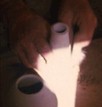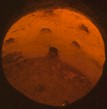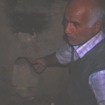Alan Caiger-Smith, “Esfahan: an
unexpected pottery workshop”,
May 10 2001: forthcoming in The
Ceramics Review
The text of this article, which is not yet
published, has been kindly lent by the author.
To read Abu'l-Qasim's treatise
(1301) on pottery production,
go to this article by James Allan: “Abu’l-Qasim’s
Treatise on Ceramics”
[Note:
the numbers in square brackets indicate the page numbers of the
original printed article]
The workshop I will try
to describe is in a side street just outside the western wall of
the bazaar. It attracted our attention because it was quiet and
peaceful while everywhere else was filled with activity. The
potter is probably in his sixties, though at first sight he seems
older. He was sitting on a stool in the street, pencilling a
floral design on a vase in preparation for painting it. Beside
him, steps led down into his subterranean workshop. There was
very little inside, only the wheel and various tools, bags
containing materials and a small group of tiles and pots of
various kinds on the floor.
He invited us in, my son
Martin and me and our Iranian friend Shahram, who interpreted for
us. Unlike the other potters I had met, he used a white clay and
his pots were quite small, nothing being more than about ten
inches high. He said that this was the material his father had
taught him to use and that he did everything just as his father
had shown him. Clearly, he revered his father. He showed us the
faded photograph on the wall with himself as a young man kneeling
beside the bearded old master-potter. He proudly produced one of
father’s jars, a fine pot decorated [in] underglaze with a
simple classical floral design in several colours. The white clay
of the unglazed foot showed that it was made from what is now
known as siliceous paste. This was the synthesised clay body that
was generally used for fine, glazed pottery in Persia centuries
ago and was described by Abu’l-Qasim of Kashan in his
Treatise of 1301. (Translated
and annotated by J. W. Allan, “Abu’l-Qasim’s
Treatise on Ceramics”, Iran XI, 1973). The clay can be thought of as a forerunner of
soft paste porcelain. In its day it was a unique way of producing
a hard white clay body with a good glaze fit at low temperature.
Modern kilns and glaze materials have not exactly superseded it,
but they have led to simpler alternative kinds of glazed
ceramics. The paste is not easy to work with and it needs
preparation. Hans Wulff found that it was still used by a few
potters in the 1950s (Traditional Crafts of Persia, 1955, p.165)
but I had supposed that by now it might have passed out of use.
When we asked more about
the clay he said “If you can wait a quarter of an hour I
will prepare a little and make something on the wheel.” He
picked up two large pieces of flint and struck them together.
“These are the stones for making fire”, he said.
“My father taught me to make powder from this stone for
preparing the clay.” He struck off some pieces on to a
little pile that had already been prepared, crushed then on the
floor with a flat stone, and sieved them. He made a small pile of
the fine particles and added a white powder of ground glass.
“It comes from these”, he said, lifting a cracked glass
lamp out of the corner. Then, using a chunk of stone, he knocked
a piece off a block of white material resembling limestone. He
made me feel it and smell it. It seemed more like rock than clay.
“It’s hard now”, he said, “but with water it
becomes soft. This is Boté clay (gel-e-Boté). It comes from
about three hundred kilometres north of Esfahan”. I asked if
it was the same as white Luri clay, which Abu’l-Qasim had
written about. He didn’t know, nor did
Abu’l-Qasim’s name mean anything to him. (It might
possibly be the same material [2] known by a different name, for
Luristan is a large area in the north west of Iran).
For some while he
squatted on the floor, kneading the flint, the glass and the
white clay together again and again into a ball. “I can
throw this on the wheel for you now”, he said, “but it
is really better if it is left till tomorrow. It swells
overnight.” (Abu’l-Qasim says exactly the same).
He mounted his wheel,
turning the flywheel with his foot, and began to sing.
“Singing helps me to work better”, he said. As he sang
he centred the clay and slowly drew up a small cylinder which he
then widened. He worked very carefully. One could see that it was
a difficult material to fashion, unlike the earthenware clays
used by other potters. I was delighted to follow enough of the
song to recognise it. It was Omar Khayyam’s verse about
visiting the potter’s house under the crescent moon, with
the clay population standing round in rows.
He cut the form off the
wheel and proceeded to make another form, much narrower. He cut
this off in turn and placed above the first one. “Tomorrow
the neck can be joined”, he said. “With this material
the pot cannot all be made in one piece.” (This is exactly
what one finds in the old pots made of siliceous paste. Hollow
ware was often made by assembling several units, body, neck and
foot, because the clay was not plastic enough to enable the whole
form to be made from a single lump.) “When I was a small
boy,” he said, “I kept asking my father to teach me,
but he wouldn’t. ‘Show me what you can do by
yourself!’ he said. I worked very hard and eventually I
managed to make something to show him. ‘Good!’ he said,
‘now you have made a beginning I can teach you.’ He was
a wise man, my father.”
We returned next day. The
two thrown pieces were still by the wheel, by this time almost
dry. The potter whittled down the neck with a knife till it
fitted the rim of the little pot. I asked if was too dry join.
“It can still be joined”, he said. “I wet the clay
and the pieces will fit together”. (This would not apply to
most clays, the white Boté clay is unusual and must behave
differently).
From another kind of
siliceous paste, firing a buff colour instead of white, he makes
the small disks which are used in the mosque during prayers.
“They cannot be scratched or chipped”, he commented,
passing one to me to feel. It was as hard as fine granite.
Then he showed us the
kiln. It was square sided, the walls being supported with light
iron rods, but internally it was about two metres deep, a round
updraught kiln, just as Abu’l-Qasim described. Most
traditional kilns in Iran seem to be round. This one, however,
had two flat, wide shelflike projections around the inside, one
about two feet above the other, surrounding the central hole
which went down the the bottom, at one side of which was the
firemouth. The top a shallow dome, covered with a mixture of clay
and hay. He demonstrated how the central aperture could be closed
with large tiles during the firing, leaving a vent for the
escaping fumes. There were also five or six other small vents
spaced around the vault to equalise the pull of the draught.
Since the workshop was built of stone and stucco it could not
burn down. Nonetheless, the place must have been densely smoky
when the kiln was firing, for there was no sign of any
ventilation. The [3] walls were certainly very black. “When
I pack the kiln”, he said, “they lower me down on a
rope. Before the pots go in I have to put in the pegs. Here they
are. They go into the holes in the wall.” I could hardly
believe that I was really seeing a kind of kiln that I had read
about in a book written seven hundred years ago. “Now”,
he said, “these small shelves are placed on the pegs and the
pots sit on the shelves.” Again, it was just as
Abu’l-Qasim had described.
The firing is done with
wood, mostly broken packing cases. How did he know when to stop
the firing? “You must know,” he said, “that at
first the pots go all black because of the smoke. Then they get
clean and after that the glaze begins to shine with heat. By the
fireplace you can see two holes where the wood goes in. I start
with the lower one, then later I use them both. After five hours
the pots will be perfectly finished.” He discoursed in a
most animated way with Shahram about the process of firing, now
laughing and making explanatory mime, now whispering
conspiratorially as if communicating a secret, all with dramatic
facial expressions. I missed much of this, but having often fired
kilns myself I think I got the drift of it.
The pots are fired once
only. The decoration is painted direct on the clay and it is then
covered with the glaze, which is poured into or over the pots
from a bowl. If it is uneven it can be smoothed down once it
dries. When fired it is shiny and extremely smooth. He slid a
sherd of glazed ware over my cheek to show how nice it feels.
“The glaze and the clay bind together more strongly than
with other kinds of pottery”, he said. “Other glazes
can be chipped off if you hit them with a stone”. He
demonstrated this with a piece of broken earthenware. “But
my glaze won’t come away”. He struck one of his own
pots to prove the point. (The glaze-body interface is indeed very
strong in siliceous paste vessels, despite the low firing
temperature, because the glass in the body fuses with the glaze
covering).
He does not prepare the
glaze frit in the way Abu’l-Qasim described, by pouring the
liquid melt into water ‘with a sound like thunder’, but
uses a ground frit which he says comes from Europe. This
realistic piece of modernisation was the only way in which his
methods differed from past practice. He does not know what the
material is, but it it probably an alkaline frit, similar to the
material prepared in the past. He adds powdered glass to this
frit, the same powder as is used in preparing the clay body. I do
not undersand why, but it works and there is no crazing in the
glaze surface. I don’t think he understands why either. This
is what his father told him to do and he keeps to it. His name is
Haj Abbas Massoumzadeh. He is a simple man, and he is poor. He
has an old book of Sa’adi’s verses (his father’s)
but Shahram says he probably cannot read it. He sings with
feeling and he seems to know much of Omar Khayyam and Sa’adi
by heart and probably the mystical lyrics of Hafez and other
poetry besides. There are no signs of his being a great potter:
there were not many pots around at the time of our visit and, as
he says, the best of them were made by his father. But he has
deep enthusiasm and an engaging sense of humour. He knows his
craft and is treated with affection and respect by his
neighbours, several of whom came in and out during our
conversations. What a fortunate encounter with an age-old
tradition! It appeared to happen by chance, yet it was one of
those events that seem to have been waiting to come about for a
long time.
[4] If only his father
had also been able to teach him about lustre (zarin fam)
which Abu’l-Qasim called ‘the enamel of two
firings’! Perhaps that tradition really has died out. If any
reader knows any sign of its continuation in Iran today I should
be grateful to hear of it.
| Slide
Illustrations:
Click on the thumbnails to see larger
versions of these pictures |
|
|
| |
|
|
|
|
|
|
|
|
|
|
|
|
|
|
| 1 |
|
2 |
|
3 |
|
4 |
|
5 |
|
6 |
|
7 |
|
8 |
 |
|
 |
|
 |
|
 |
|
 |
|
 |
|
 |
|
 |
Preparing the
clay-paste |
|
At the wheel |
|
At the wheel |
|
Trimming
the neck |
|
Downward view
into the kiln |
|
Two kiln pegs
with a shelf
on them |
|
Firebox with
two stoke-holes |
|
Preparing
the glaze |
To read Abu'l-Qasim's treatise (1301) on pottery
production,
go to this article by James Allan: “Abu’l-Qasim’s
Treatise on Ceramics”







